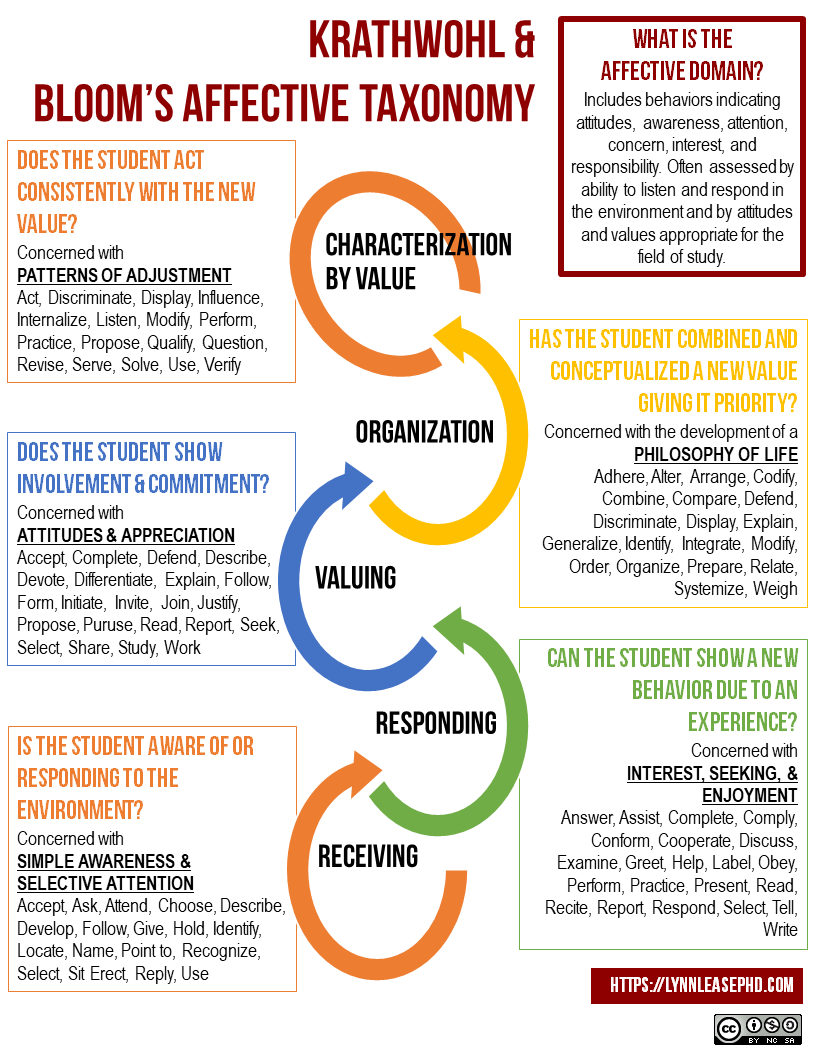Most educators are familiar with Bloom’s Taxonomy, which focuses mostly on the cognitive domain of learning and knowledge-based objectives and outcomes. But, there is often more to learning than obtaining knowledge.
Three domains of learning:
- Cognitive (Knowledge)
- Psychomotor (Skills)
- Affective (Attitudes/Values)
What is the Affective Domain Taxonomy?
- Includes learner behaviors indicating attitudes, awareness, attention, concern, interest, and responsibility.
- Often assessed by the learner’s ability to listen and respond in the environment and by attitudes and values appropriate for the field of study.
Parts of the Affective Domain Taxonomy
The parts are listed from lowest-level to highest level:
Receiving – Is the learner aware of or responding to the environment? The focus is on simple awareness and selective attention.
RECEIVING VERBS:
Accept, Ask, Attend, Choose, Describe, Develop, Follow, Give, Hold, Identify, Locate, Name, Point to, Recognize, Select, Sit Erect, Reply, Use
Responding – Can the learner show a new behavior due to an experience? The focus is on interest, seeking, and enjoyment.
RESPONDING VERBS:
Answer, Assist, Complete, Comply, Conform, Cooperate, Discuss,
Examine, Greet, Help, Label, Obey, Perform, Practice, Present, Read, Recite, Report, Respond, Select, Tell, Write
Valuing – Does the learner show involvement and commitment? The focus is on attitudes and appreciation.
VALUING VERBS:
Accept, Complete, Defend, Describe, Devote, Differentiate, Explain, Follow, Form, Initiate, Invite, Join, Justify, Propose, Puruse, Read, Report, Seek, Select, Share, Study, Work
Organization – Has the learner combined and conceptualized a new value giving it priority? The focus is on philosophy of life.
ORGANIZATION VERBS:
Adhere, Alter, Arrange, Codify, Combine, Compare, Defend, Discriminate, Display, Explain, Generalize, Identify, Integrate, Modify, Order, Organize, Prepare, Relate, Systemize, Weigh
Characterization by Value – Does the learner act consistently with the new value? The focus is on patterns of adjustment.
CHARACTERIZATION BY VALUE VERBS:
Act, Discriminate, Display, Influence, Internalize, Listen, Modify, Perform, Practice, Propose, Qualify, Question, Revise, Serve, Solve, Use, Verify

great! finally, I found a clear explanation.
LikeLiked by 1 person